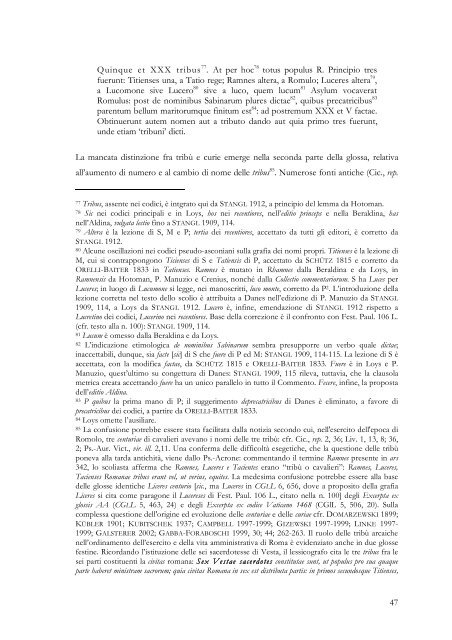3Eterov e)ce(te/rou sofo\v to/ te pa/lai to/ te nu=n. Ou ... - EleA@UniSA
3Eterov e)ce(te/rou sofo\v to/ te pa/lai to/ te nu=n. Ou ... - EleA@UniSA
3Eterov e)ce(te/rou sofo\v to/ te pa/lai to/ te nu=n. Ou ... - EleA@UniSA
You also want an ePaper? Increase the reach of your titles
YUMPU automatically turns print PDFs into web optimized ePapers that Google loves.
Quinque et XXX tribus 77 . At per hoc 78 <strong>to</strong>tus populus R. Principio tres<br />
fuerunt: Titienses una, a Tatio rege; Ramnes al<strong>te</strong>ra, a Romulo; Lu<strong>ce</strong>res al<strong>te</strong>ra 79 ,<br />
a Lucomone sive Lu<strong>ce</strong>ro 80 sive a luco, quem lucum 81 Asylum vocaverat<br />
Romulus: post de nominibus Sabinarum plures dictae 82 , quibus precatricibus 83<br />
<strong>pa</strong>rentum bellum mari<strong>to</strong>rumque finitum est 84 : ad postremum XXX et V factae.<br />
Obtinuerunt au<strong>te</strong>m nomen aut a tribu<strong>to</strong> dando aut quia primo tres fuerunt,<br />
unde etiam ‘tribuni’ dicti.<br />
La mancata distinzione fra tribù e curie emerge nella seconda <strong>pa</strong>r<strong>te</strong> della glossa, relativa<br />
all’aumen<strong>to</strong> di numero e al cambio di nome delle tribus 85 . Numerose fonti antiche (Cic., rep.<br />
77 Tribus, assen<strong>te</strong> nei codici, è intgra<strong>to</strong> qui da STANGL 1912, a principio del lemma da Ho<strong>to</strong>man.<br />
78 Sic nei codici princi<strong>pa</strong>li e in Loys, hos nei re<strong>ce</strong>ntiores, nell’editio prin<strong>ce</strong>ps e nella Beraldina, has<br />
nell’Aldina, vulgata lectio fino a STANGL 1909, 114.<br />
79 Al<strong>te</strong>ra è la lezione di S, M e P; <strong>te</strong>rtia dei re<strong>ce</strong>ntiores, ac<strong>ce</strong>tta<strong>to</strong> da tutti gli edi<strong>to</strong>ri, è corret<strong>to</strong> da<br />
STANGL 1912.<br />
80 Alcune oscillazioni nei codici pseudo-asconiani sulla grafia dei nomi propri. Titienses è la lezione di<br />
M, cui si contrappongono Ticienses di S e Tatiensis di P, ac<strong>ce</strong>tta<strong>to</strong> da SCHÜTZ 1815 e corret<strong>to</strong> da<br />
ORELLI-BAITER 1833 in Tatienses. Ramnes è muta<strong>to</strong> in Rhamnes dalla Beraldina e da Loys, in<br />
Ramnensis da Ho<strong>to</strong>man, P. Manuzio e Crenius, nonché dalla Collectio commentariorum. S ha Lu<strong>ce</strong>s per<br />
Lu<strong>ce</strong>res; in luogo di Lucumone si legge, nei manoscritti, luco mon<strong>te</strong>, corret<strong>to</strong> da P 2. L’introduzione della<br />
lezione corretta nel <strong>te</strong>s<strong>to</strong> dello scolio è attribuita a Danes nell’edizione di P. Manuzio da STANGL<br />
1909, 114, a Loys da STANGL 1912. Lu<strong>ce</strong>ro è, infine, emendazione di STANGL 1912 rispet<strong>to</strong> a<br />
Lucretino dei codici, Lu<strong>ce</strong>rino nei re<strong>ce</strong>ntiores. Base della correzione è il confron<strong>to</strong> con Fest. Paul. 106 L.<br />
(cfr. <strong>te</strong>s<strong>to</strong> alla n. 100): STANGL 1909, 114.<br />
81 Lucum è omesso dalla Beraldina e da Loys.<br />
82 L’indicazione etimologica de nominibus Sabinarum sembra presupporre un verbo quale dictae;<br />
inac<strong>ce</strong>ttabili, dunque, sia fac<strong>te</strong> [sic] di S che fuere di P ed M: STANGL 1909, 114-115. La lezione di S è<br />
ac<strong>ce</strong>ttata, con la modifica factae, da SCHÜTZ 1815 e ORELLI-BAITER 1833. Fuere è in Loys e P.<br />
Manuzio, quest’ultimo su congettura di Danes: STANGL 1909, 115 rileva, tuttavia, che la clausola<br />
metrica creata ac<strong>ce</strong>ttando fuere ha un unico <strong>pa</strong>rallelo in tut<strong>to</strong> il Commen<strong>to</strong>. Fe<strong>ce</strong>re, infine, la proposta<br />
dell’editio Aldina.<br />
83 P quibus la prima mano di P; il suggerimen<strong>to</strong> deprecatricibus di Danes è elimina<strong>to</strong>, a favore di<br />
precatricibus dei codici, a <strong>pa</strong>rtire da ORELLI-BAITER 1833.<br />
84 Loys omet<strong>te</strong> l’ausiliare.<br />
85 La confusione potrebbe essere stata facilitata dalla notizia secondo cui, nell'eserci<strong>to</strong> dell'epoca di<br />
Romolo, tre <strong>ce</strong>nturiae di cavalieri avevano i nomi delle tre tribù: cfr. Cic., rep. 2, 36; Liv. 1, 13, 8; 36,<br />
2; Ps.-Aur. Vict., vir. ill. 2,11. Una conferma delle difficoltà esegetiche, che la questione delle tribù<br />
poneva alla tarda antichità, viene dallo Ps.-Acrone: commentando il <strong>te</strong>rmine Ramnes presen<strong>te</strong> in ars<br />
342, lo scoliasta afferma che Ramnes, Lu<strong>ce</strong>res e Tacien<strong>te</strong>s erano “tribù o cavalieri”: Ramnes, Lu<strong>ce</strong>res,<br />
Tacienses Romanae tribus erant vel, ut verius, equi<strong>te</strong>s. La medesima confusione potrebbe essere alla base<br />
delle glosse identiche Li<strong>ce</strong>res <strong>ce</strong>nturio [sic., ma Lu<strong>ce</strong>res in CGLL 6, 656, dove a proposi<strong>to</strong> della grafia<br />
Li<strong>ce</strong>res si cita come <strong>pa</strong>ragone il Lu<strong>ce</strong>reses di Fest. Paul. 106 L., cita<strong>to</strong> nella n. 100] degli Ex<strong>ce</strong>rpta ex<br />
glossis AA (CGLL 5, 463, 24) e degli Ex<strong>ce</strong>rpta ex codi<strong>ce</strong> Vaticano 1468 (CGlL 5, 506, 20). Sulla<br />
complessa questione dell'origine ed evoluzione delle <strong>ce</strong>nturiae e delle curiae cfr. DOMARZEWSKI 1899;<br />
KÜBLER 1901; KUBITSCHEK 1937; CAMPBELL 1997-1999; GIZEWSKI 1997-1999; LINKE 1997-<br />
1999; GALSTERER 2002; GABBA-FORABOSCHI 1999, 30; 44; 262-263. Il ruolo delle tribù arcaiche<br />
nell’ordinamen<strong>to</strong> dell’eserci<strong>to</strong> e della vita amministrativa di Roma è evidenzia<strong>to</strong> anche in due glosse<br />
festine. Ricordando l’istituzione delle sei sa<strong>ce</strong>rdo<strong>te</strong>sse di Vesta, il lessicografo cita le tre tribus fra le<br />
sei <strong>pa</strong>rti costituenti la civitas romana: Sex Vestae sa<strong>ce</strong>rdo<strong>te</strong>s constitutae sunt, ut populus pro sua quaque<br />
<strong>pa</strong>r<strong>te</strong> haberet ministram sacrorum; quia civitas Romana in sex est distributa <strong>pa</strong>rtis: in primos secundosque Titienses,<br />
47
















